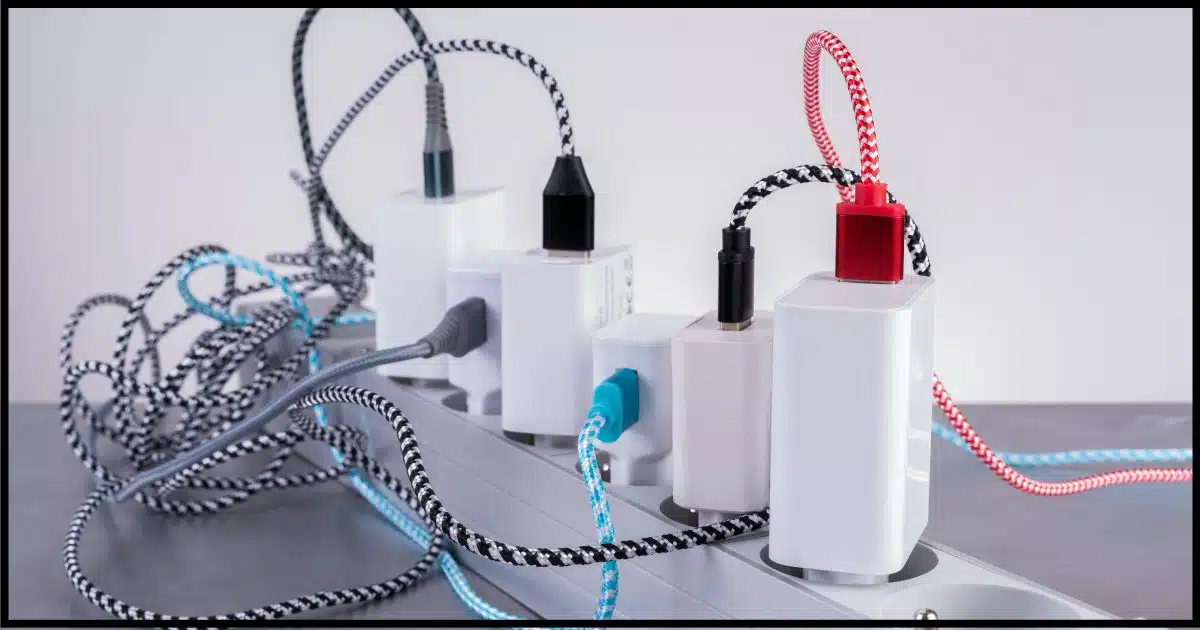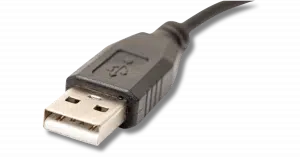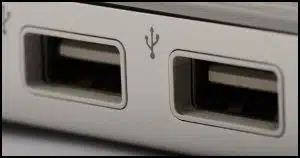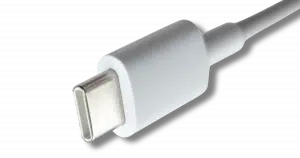At worst, slower than it could be, but that’s fixable too.

USB standardization has made all of this much simpler.
For the most part, if the cables fit, your device will charge safely. Slowly, perhaps, but safely. There are exceptions, but when talking about portable devices, it’s rare.

USB charging
USB has simplified charging dramatically. Most cables just pass power through, so if it fits, it works. It may be slower, but it’ll be safe. USB-A always means five volts, while USB-C is smarter: device, charger, and even cable “talk” to each other to decide the fastest, best, and safest speed. Missing chargers? Standard ones are everywhere and work fine.
USB-A
The older, larger, square plug and socket used for years is the USB-A socket. Regardless of what’s at the other end of a USB cable, if one end is USB-A, this tells us pretty much everything we need to know.

USB-A supports five volts. That’s part of the definition of the USB standard.

Originally, USB-A ports were limited by the USB specification to providing only half an amp of power (0.5A or 500ma), though that’s been increased in USB 3 to nearly twice that (900ma), and even 1.5 amps in a charging-specific specification.
The upshot is that if your device uses a USB cable of any sort to charge, and that cable plugs into a USB-A connector, it’ll work. The USB standard defines everything we care about.
It may charge more slowly than it could, though. That’s where USB-C factors in.
Help keep it going by becoming a Patron.
USB-C
USB-C is a newer, smaller, more flexible version of the USB family of connectors.

USB-C is smaller than USB-A, has more wire connections (24 compared to 4), and is symmetrical, meaning you can plug it in either way; there is no right-side-up to figure out.

USB-C is a more flexible but slightly more complicated solution for power delivery. It’s not limited to five volts. USB-C may provide:
- 5 volts
- 9 volts
- 15 volts
- 20 volts
Later versions of the protocol have expanded to include 28, 36, and 48 volts as part of the EPR, or Extended Power Range, addition.
Here’s the trick: when you plug in a device — say your phone — into a USB-C socket, the phone and power supply have a little “conversation” about:
- What voltage(s) the power supply can supply
- What voltage(s) the device can accept
If there’s no conversation, the default is our old friend, five volts. On the other hand, if the two can negotiate something better, that’s what they use. If that happens, your device will charge faster.
A cable is just a cable, mostly
When it comes to your mobile phone and other small portable devices, a USB cable is just a cable. Wires in the connector at one end pass through to the connector at the other. If you can plug it into a power supply at one end and your device at the other, then the cable will work and your device will charge.
These are referred to as passive cables. They do nothing other than connect.
Some (or even most) USB-C cables have a chip as part of the cable that, among other things, identifies the cable’s capabilities. For example, extended power capabilities can range up to 240 watts of power delivery, which requires a cable capable of safely transferring that much power.
This means that the “conversation” between power supply and device now includes a third voice: the cable connecting the two. The conversation then covers:
- What the power supply can supply
- What the device can accept
- What the cable can handle
The goal is for them to agree on the safest, highest-power delivery.
The case of the missing charger

As you pointed out, more and more devices come without a charger. This is an attempt to reduce electronic waste, since:
- We have so many devices that come with chargers.
- The chargers usually outlast the devices they came with.
Given that USB-based chargers are the emerging standard, each device no longer needs a unique charger. The chargers we’ve already accumulated will do just fine. Assuming the cables fit and connect, you’re mostly done.
And if you find yourself short a charger, they’re standard, inexpensive, and easy to find.
Do this
USB has simplified the charging landscape. As long as you have a USB charger and a cable that can connect your USB-compatible device, you’re essentially done. The only optimization you might consider is making sure that if your device uses USB-C, you use a USB-C charger to take advantage of potentially higher charging speeds.
Subscribe to Confident Computing! Less frustration and more confidence, solutions, answers, and tips in your inbox every week.



Great article! I feel obliged to mention a couple of things:
1. If a charge cable is at all damaged, especially if it looks like it got hot, get rid of it right away.
2. You don’t need to spend top dollars for cables (I’m looking at you, Apple!) but avoid the very cheap dollar-store cables.
3. Don’t cover the charger, the cable, or the device with a pillow or a blanket. Charging devices generate heat that must be dissipated.
4. Some devices might work with a smaller charger, but not well. If it’s acting up, try a bigger charger (that delivers more watts).
Thanks, Leo!
My *new* phone came with a double ended USB-C cable and since it’s my only device with a USB-C connection, I had to buy a USB-C charger block for it. I also bought a 4 pack of 2xUSB-C to USB-A & 2xUSB-A to USB-C female adapters so I could use the new charger with my older USB-A devices and also charge my new phone in my car with its USB-A charging ports. All seem to work well but I’m just wondering…
Power limitations aside, does the use of these adapters create any troubling issues between the devices, adapters, and the charger combos being used?
You could have simplified the setup by using a USB-C male to USB-A female plug adapter, which converts the end of your double-ended USB-C cable into a USB-A plug, although a USB-C block is probably the better choice because it will likely charge faster, as it has the potential for higher voltages.
Some cables only charge and some will let information go through. How do you tell the difference?
Unfortunately, there are no visual clues. Some charge-only cables even have all the pins but no data lines wired. Always check the packaging or test it with a device.
If there’s no visible indicator or label, you can’t really tell by looking. Jus try the cable.
My husband thought his Apple Macbook died, but it turned out it only needed charging. He had been using a generic cable and a Phillips charging block (with varying outputs from 5 to 20 volts, 3.0 amps). When he called tech support for help, he was told he had to use an Apple charging block. He switched and the computer charged up just fine. I just switched it back to the Phillips block, and the computer says it is charging. Any idea what’s going on here?
Did you change the cable, perhaps?
USB-A is rectangular, not square!
So are Sponge Bob’s pants 😉
I read somewhere that charging cell phones with a lower-voltage charger prolongs battery life. If that’s so, users should consider that factor in selecting and using charger blocks.
I believe they got it wrong a lower amperage might run cooler but a lower voltage might cause problems. Sticking with the manufacturer’s recommended voltage and amperage is the safest and smartest choice for maintaining battery health and device performance. Charging between 20% & 80% can help preserve battery life.
Thanks for this information. I had no idea how ignorant I was. Isn’t that the definition of ignorance? Thinking you know but you don’t know? LOL
The article on USB charging was helpful; however, it left a question: can using a USB cable for charging from a public power source (for example, at an airport) pose any risk of intrusion?
In theory, yes. It’s been mentioned, but to the best of my knowledge it’s never actually been seen in the wild.
See: Is “Juice Jacking” Real?
No one has mentioned the speed of data transfer rate. I have learned that some of the newest USB-C ports can transfer data faster than the earlier versions but if and only if you have an appropriate cable. So I bought a cable that supported the higher data rate which was great but nothing on the cable indicates it is anything different than any other USB-C to USB-C cable so I had to label that cable. Very confusing situation.
There’s a 68K ohm “pullup resistor” in there somewhere on some cables just to confuse us all over again.
I know there is USB A and C. I think there maybe a USB B cuz I have cables that don’t fit USB A or C??
This is USB-B

I have a braided USB 3 A-C that I can use to attach my camera to my PC for tethering and file transfers. It has a right-angle USB-C. With a bracket attached to the camera, there is some bending pressure on the angled end cable against the bracket. The last thing I need is for the camera’s USB-C connector to come loose or break. I thought I would get a cable with a “flat” USB-C end(not angled). But all the cables I see online specify usage for particular devices and USB generations (3/Gen 1, 3.2, etc), with supposed compatibility to other devices. All I need is a data transfer cable with the fastest speed possible. Longer is better so I can move around more while being tethered. I have 2 USB A-A extenders (one powered, one not) I could possibly use instead, but I don’t want extenders to drastically decrease transfer speed. I’ve tried a few A-C cables that come with other devices to connect the camera to the PC—the PC will sometimes see the camera as an attached SSD, but it can’t see the camera with other cables. Anyway, I hope this all makes sense, but please ask if anything is unclear. I appreciate anyone’s insight on the best way to approach this. Thanks!